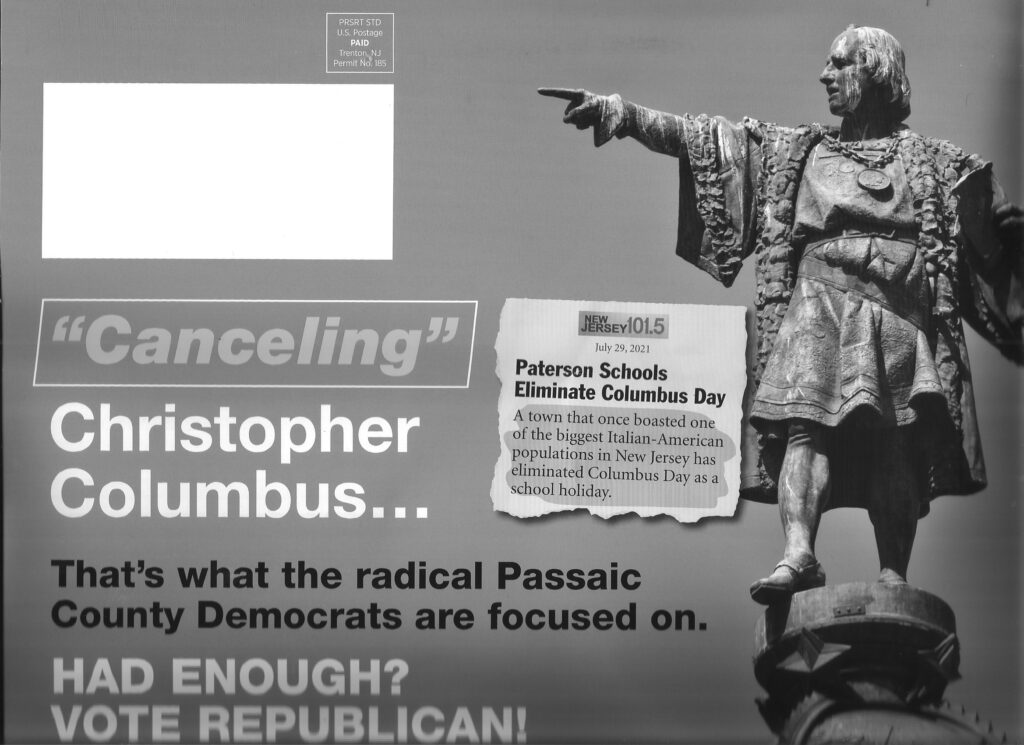New Jerseyans Discover Columbus

Christopher Columbus, titled Admiral of the Ocean Sea, is believed to be Genoese, and the tradition holds, despite relatively little reliable biographical information available about the most famous explorer in history. Every schoolkid knows—or should know—that Queen Isabella and King Ferdinand of Spain financed Columbus’ voyages to discover a trade route to the Indies and he invertedly came to the Americas. Columbus miscalculated the size of the Earth and, perhaps stubbornly refusing to believe that “India” he found didn’t resemble the “India” he was supposed to find, went to his grave believing he had, in fact, come to Asia.
Since that time, Columbus has come to represent a number of things, depending on one’s perspective. He represents the triumphal spirit of exploration and the courage to face danger, opening a new hemisphere to contact with another. To others, his arrival represents the decimation of the native populations, their culture, and way of life since the Spanish presence quickly led to the arrival of conquistadors, such as Hernan Cortez, Francisco Pizarro, Juan de Onate, and others. The trans-Atlantic African Slave Trade began and the Native American populations were becoming displaced, assimilated, and killed either through war, disease, poverty, or combinations of all of the above.
The 15th Century is a half a millennium ago now, but in the 21st Century the famous navigator continues to make waves. And just like Columbus missed the orient, the Passaic County Republicans missed the point after sending out a mailer trying to stir up some notice by stoking the culture war.
A Passaic County source, and a staunch Trump-Republican, admitted that he had no idea who Surrogate candidate Aisha Mamkej, and commissioner (formerly freeholder) candidates William Marsala, Nicolino Gallo, and Aileen Rivera are, and blamed chairman Peter Murphy for not supporting candidates who have better name recognition.
It may be an unfair charge to lob at the chairman, however, when Passaic County Democrats, helmed by former state chairman John Currie, have been solidly in control for years. Where can a Republican trying to sprout reach the sunlight when the canopy has been dominated by Democrats?
That is what the Republicans have tried to charge against in their mailer which read, “It’s time for a check and balance on one-party control.” And so they cited an NJ 101.5 article, which in turn was derived from a Paterson Press article by Joe Malinconico from July when he reported the Paterson school board changed “Columbus Day” to “Italian Heritage Day/Indigenous Peoples Day.”
The slate blasted “politically correct cancel culture” and swore to lower taxes, reduce crime, and “bring common sense people together to make our county a better place.”
The county does not decide what the Paterson schools call their holidays. The candidates are, however, tapping into the sensitivities of identity-politics, usually a field associated with the Left. In Randolph, Insider NJ reporter Fred Snowflack covered the chaotic events which unfolded after the school board changed Columbus Day to Indigenous Peoples Day without notice. This provoked a blood-and-soil firestorm, and then, in an ill-conceived knee-jerk response, the board erased the names of all holidays, and then reversed course again, and reverted the school calendar as it was before with Columbus Day restored.
Columbus statues across the state have been taken down, notably in cities like Trenton and Newark, where reassessments of the explorer mean he is no longer welcome. To others, however, it is the erasing of history, an act which says these cities are ashamed of not just Columbus, but “America” itself (being the United States specifically). Further, the removal of Columbus has been seen, to some, as an attack on Italian-American identity.
The irony, however, is that Christopher Columbus was largely lost in the American consciousness until the late 19th Century with the arrival of large numbers of Italian immigrants. After all, to the largely Anglo-Saxon Americans before, Columbus was not one of them. He did not land in the United States, but came to the Bahamian island of Guanahani. He named the island San Salvador, after having survived a dangerous and harrowing voyage in three tiny ships through unknown waters. He made four voyages to the New World, sailing around the Caribbean Sea, Cuba, and central America but never came to what would become the continental United States. This was “Asia”, though an inconveniently non-Asian Asia at that. He was also a Roman Catholic, advancing the expansion of “Popery.” Of the original thirteen colonies, only Maryland was considered a particularly safe place to be openly Catholic.
As Italian-Americans settled in the United States, predominantly in the NY/NJ area, they faced discrimination and abuse by nativists, just as the Irish and Jewish immigrants had. To better assert their American-ness, Italians and Italian-Americans rallied around Columbus, the Genoese explorer. The link was clear—without Italians, there would be no United States as we know it.
The choice of Columbus particularly is less important, other than the fact that he was the first to come in the Age of Discovery. Other Italian explorers such as Venetian Giovanni Caboto (sailing for England in 1497), Florentine Amerigo Vespucci (sailing for Spain in 1499), and fellow Florentine Giovanni da Verrazzano (sailing for France in 1523), all knew they had come to a previously unknown land. Nevertheless, Columbus was first, yet did not carry the greatest name. The nation of Colombia is named for Christopher, but “the Americas” are named for Signor Vespucci.
In 2021, on the federal level, President Biden officially proclaimed Indigenous Peoples Day as well as Columbus Day for October 11. This represents the first time Indigenous Peoples Day has been proclaimed from DC and, notably, does not replace Columbus Day. Biden has appealed to both and, in so doing, detracted from neither.
As a nation, we are also ignoring Leif Erikson, whose own holiday—Leif Erikson Day—passed with barely any notice on October 9. That Norse explorer arrived in Canada from Greenland, and possibly voyaged as far south as the continental US, circa the year 1000. But the Viking settlements in “Vinland” did not endure long and were largely forgotten. You won’t see any longships on election mailers, lamenting the lack of attention for America’s Norwegian-Icelandic population, at least not in the Garden State.
When Columbus came to the Americas, the Europeans were here to stay. And so too, it seems, the debate over the man’s legacy and proper place in the public arena.





